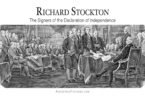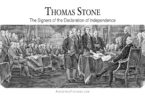Francis Hopkinson was born October 2, 1737, to Thomas Hopkinson and Mary Johnson. He was born in Philadelphia, Pennsylvania, and later married Ann Borden, with whom he would have five children. One of those children was Joseph Hopkinson, who became a member of the US House of Representatives and a federal judge.
Francis attended the College of Philadelphia (which is now known as the University of Pennsylvania), where he received a Bachelor’s degree in 1757 and a Master’s degree in 1760. After graduating with his Master’s degree, Francis distinguished himself in a number of ways. He was, for example, the first North American-born person of European descent to compose a secular song (all other songs written by North American colonists were religious songs prior to Francis writing his song in 1759.
Other ways in which Francis distinguished himself included:
- Becoming the Secretary of a Commission of the Provincial Council of Pennsylvania. This commission made a treaty between Pennsylvania and a select number of Native American tribes in 1761.
- Becoming the Collector of Customs in Salem, New Jersey in 1763.
- Spending the period of May 1766 to August 1767 in England, making a play to become the Commissioner of Customs for North America. This play was not successful, but while he was in England, Francis did spend time with the future Prime Minister, Lord North. He also spent time with his cousin, James Johnson (on his mother’s side), and the famous painter, Benjamin West.
- Becoming a merchant in Philadelphia, where he sold a variety of fabric and port wine, beginning in 1768.
- Being elected to the American Philosophical Society the same year he became a merchant. Francis went on to serve as the Society’s curator from 1776 to 1782.
- Becoming the Collector of Customs of New Castle, Delaware from 1772 to 1773.
- Establishing his own private law practice at a few different points in his life, both in Philadelphia and New Jersey.
- Becoming a member of the New Jersey Provincial Council from 1774 to 1776.
- Becoming a member of the Executive Council of New Jersey for most of 1775.
- Becoming qualified to practice law before the bar of the Supreme Court of New Jersey the same year he became a member of the Executive Council.
- Becoming an elected Associate Justice of the New Jersey Supreme Court in 1776. Surprisingly, he declined the office.
These are all very impressive things and show Francis’s ambition and hard work to make something of himself in colonial America. It was because of this civil engagement and leadership that he was chosen as a delegate from Pennsylvania to the Second Continental Congress, a position which he stayed in from June 22, 1776, to November 30, 1776. This meant he arrived to the Congress just before the vote on ratifying the Declaration of Independence and was able to vote on it himself. He was also there to sign his name to the document.
After leaving the Continental Congress, Francis did not sit on his laurels and bask in his secured place in history. Instead, he became a member of the Navy Board of Philadelphia during the Revolutionary War, from 1776 to 1777. He was also the Treasurer for the Continental Loan Office in Philadelphia from 1778 to 1781. In addition, Francis was a Judge of the Admiralty Court of Pennsylvania from 1779 to 1789 and was a member of the Pennsylvania Convention to ratify the US Constitution after the Revolutionary War was done.
In addition to his political, civic, and judicial work, Francis was also a prolific writer and composer of music. He wrote political satires in poetical and pamphlet forms. Some of these satires were distributed and circulated around the colonies, and are considered powerful motivating items in getting the colonists into the spirit of political independence.
As for his musical accomplishments, Francis began playing the harpsichord when he was seventeen years old. During the 1750s, when he was in school and college, he hand-copied pieces of music by a large variety of European composers, so he could learn to play them himself. His harpsichord skills were good enough that he began playing in concerts with professional musicians in the 1760s. He also played the organ at Philadelphia’s Christ Church, where he composed and edited several hymns. He performed some of these hymns at the church where he played.
As if all of that were not impressive enough, Francis was a bit of an inventor and is credited with at least one invention. Not surprisingly, it was a musical one. Francis combined the glass harmonica with a keyboard in a way in which the two could be played together, and thus invented the Bellharmonic, which was an instrument that used the tones made by metal balls.
Just to make himself that much more impressive, Francis designed Continental paper money during the Revolutionary War, including the very first United States coin. He also personally designed to early prototypes of what would become the American flag. One of these prototypes was designed for the US Navy, and one was designed for the United States itself, as a country.
Francis was nominated to the United States District Court for the District of Pennsylvania in September of 1789. This appointment was made by George Washington, who was at that time the first President of the United States. A new seat was authorized to be created on the court for Francis’s new appointment there. Francis served in this position until he passed away in May of 1791, due to what was most likely a stroke. He was buried at the Christ Church Burial Ground in Philadelphia.
There is a building at Francis’s alma mater, the University of Pennsylvania, that is named after him today. This building is located in the Fisher-Hassenfeld College House. Also, his house in Burlington County, New Jersey is listed on the National Register of Historic Places.







